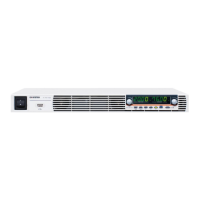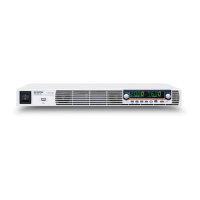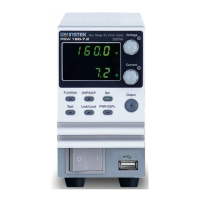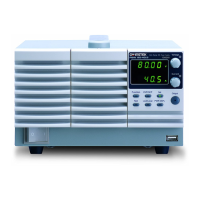
Do you have a question about the GW Instek PSU 12.5-120 and is the answer not in the manual?
| Brand | GW Instek |
|---|---|
| Model | PSU 12.5-120 |
| Category | Power Supply |
| Language | English |
Explains safety symbols used in the manual and on the instrument.
Details the PSU series models, voltage, current, and power capacities.
Lists key performance, features, and interface specifications of the PSU series.
Lists standard and optional accessories included with the PSU unit.
Describes the front panel layout and key components of the PSU series.
Explains the function of each display element and LED indicator on the PSU front panel.
Details the connectors and ports available on the rear of the PSU unit.
Explains fundamental operating principles, modes, and considerations of the PSU.
Compares operating areas of different PSU models based on voltage and current ratings.
Explains the Constant Current (CC) and Constant Voltage (CV) operating modes of the PSU.
Describes the PSU's selectable slew rates for CC and CV modes to limit current/voltage draw.
Explains the function of the bleed resistor for dissipating power from filter capacitors.
Details how internal resistance can be user-defined in software for simulating power sources.
Lists and describes the various protection features and alarm indicators of the PSU.
Discusses situations to consider when using the power supply, like inrush current and pulsed loads.
Explains PSU grounding procedures and considerations for output terminals.
Provides instructions for connecting the PSU to the power line and initial setup procedures.
Guides on connecting or replacing the power cord for universal power input.
Details the steps for powering on the PSU and its initial startup behavior.
Advises on selecting appropriate wire gauge for output cables based on current capacity.
Describes the two types of output terminals and safety precautions for handling them.
Explains how to install and remove the output terminal cover for safety.
Guides on mounting the PSU into 19-inch rack mounts using sliding mounts.
Explains the method of configuring parameter values using the voltage and current knobs.
Describes how to reset the PSU to its factory default configuration settings.
Guides on how to view the PSU's version number, build date, and other system information.
Covers essential operations like setting protection levels and modes.
Explains how to set Over Voltage, Over Current, and Under Voltage protection levels.
Guides on configuring the PSU for Constant Voltage (CV) priority mode operation.
Guides on configuring the PSU for Constant Current (CC) priority mode operation.
Explains how to activate the panel lock feature to prevent accidental changes to settings.
Details how to save current PSU settings to memory slots (M1, M2, M3).
Explains how to recall previously saved PSU settings from memory.
Covers operating the PSU using local or remote voltage sense configurations.
Describes the remote sense connector, its pinout, and guidelines for use.
Explains the importance of using the remote sense cover for safe operation.
Details the operation and recommendations for using local sense connections.
Explains the purpose and functionality of remote sense for compensating voltage drop.
Explains how to connect and operate multiple PSU units in parallel or series configurations.
Introduces the master-slave concept for parallel operation of PSU units.
Guides on wiring the analog connectors for master-slave parallel connection of PSUs.
Details the configuration and steps for operating PSUs in master-slave parallel mode.
Explains how to calibrate PSU units connected in parallel for improved accuracy.
Introduces the concept of connecting PSU units in series for increased voltage or polarity.
Illustrates the wiring methods for connecting PSU units in series.
Covers the configuration and steps for operating PSUs in series mode.
Details how to use the PSU's test script functionality for automated testing.
Describes the format and naming convention for test script files (*.tst).
Explains the settings related to test script execution, copying, exporting, and removal.
Guides on how to configure test script parameters (Run, Copy, Export, Remove).
Details the procedure for loading test scripts from a USB drive into PSU memory.
Explains how to execute a loaded test script and stop a running test.
Guides on saving test scripts from PSU memory to a USB flash drive.
Details how to delete test scripts from the PSU's internal memory.
Outlines the different configuration settings available for the PSU power supply.
Describes settings like output delay times and slew rates for normal operation.
Covers settings for USB, GPIB, UART, and Ethernet interfaces for remote control.
Details USB and GPIB interface configuration and status checking.
Explains the settings for UART communication modes, baud rates, and data bits.
Details settings that can only be configured during power-up, affecting initial PSU behavior.
Explains how to configure external trigger inputs and outputs for controlling PSU functions.
Guides on how to configure normal function parameters using the front panel.
Provides steps to configure settings that take effect upon PSU power-up.
Introduces options for controlling PSU output using external voltage or resistance.
Details the pin assignments and descriptions for the analog remote control connector.
Explains how to control PSU output voltage using an external voltage source.
Guides on controlling PSU current output using an external voltage source.
Describes controlling PSU output voltage via an external resistance.
Explains controlling PSU current output via an external resistance.
Covers controlling the PSU output state (on/off) using an external switch.
Details how to configure an external switch to shut down the PSU output.
Explains how to monitor PSU output and status remotely.
Describes monitoring PSU voltage and current outputs using the analog connector.
Explains how to monitor PSU operation and alarm status via the analog control connector.
Details the configuration of external trigger inputs and outputs for PSU control.
Details specifications and usage of isolated analog control for PSU voltage and current.
Lists accuracy, linearity, and impedance for isolated analog control options.
Introduces isolated analog connectors for external control and remote monitoring.
Guides on controlling PSU voltage output using an isolated external voltage source.
Guides on controlling PSU current output using an isolated external voltage source.
Explains controlling PSU voltage output using an isolated external current source.
Details controlling PSU current output using an isolated external current source.
Describes monitoring PSU voltage and current using isolated analog outputs.
Covers the setup and configuration of USB, GPIB, UART, and Ethernet interfaces.
Details the configuration and connection steps for USB remote control of the PSU.
Explains how to verify the functionality of the USB remote interface.
Guides on configuring and connecting the PSU for GPIB remote control.
Describes how to test the GPIB interface functionality using external software.
Provides details on configuring UART communication for remote control via RS232/RS485.
Explains how to daisy-chain and control multiple PSU units via RS485 or LAN/USB.
Details the legacy multi-drop mode for controlling multiple PSUs via RS232/RS485.
Describes the multi-drop mode for controlling multiple PSUs via LAN/USB/GPIB.
Explains how to verify the functionality of multi-unit connections.
Guides on setting up the PSU for Ethernet communication and web server functionality.
Details the steps to configure the PSU as a web server using DHCP.
Explains how to configure the PSU as a socket server with manual IP assignment.
Describes how to test the socket server functionality using NI Measurement & Automation Explorer.
Lists the default configuration settings for the PSU power supply, with details on how to restore them.
Provides a reference for error and normal messages displayed on the PSU screen during operation.
Explains how to interpret LED display messages using an ASCII table for character representation.
Details the electrical and performance specifications for all PSU models, including output, voltage, current, and modes.
Lists the rated output voltage, current, and power for each PSU model.
Provides specifications for line regulation, load regulation, ripple, noise, and temperature coefficients in CV mode.
Provides specifications for line regulation, load regulation, ripple, noise, and temperature coefficients in CC mode.
Details the setting ranges and accuracies for Over Voltage, Over Current, and Under Voltage limit protections.
Lists the indications, buttons, knobs, and USB port details for the PSU front panel.
Provides programming and measurement accuracy and resolution specifications for various communication interfaces.
Details PSU input specifications like voltage range, frequency, input current, and power factor.
Outlines the capabilities of USB, LAN, RS-232/RS-485, and GPIB interfaces.
Lists operating and storage temperature, humidity, and altitude limits for the PSU.
Covers PSU weight, dimensions, cooling, EMC, safety, withstand voltage, and insulation resistance.
Provides detailed physical dimensions and mounting diagrams for the PSU units.
Lists compliance certifications and standards met by the PSU product, including EMC and Safety directives.











